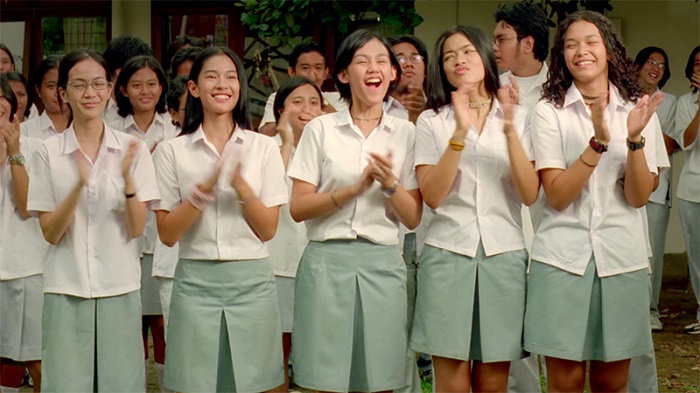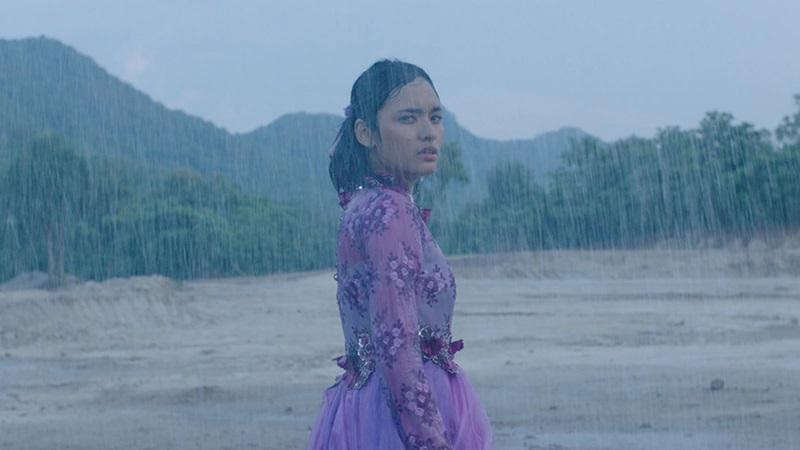Two decades after the cultural shift opened up by Reformasi, hope looks very different in Indonesian cinema
Annisa R. Beta
‘I always thought I could be anything. Now, I don’t know’, says Yuni, the protagonist of the eponymous film. She gazes away from Yoga, one of her love interests, who is sitting next to her. He asks her to run away with him. Nothing good is left in the town; the mountain has been dredged out, Yoga convinces Yuni. But she doesn’t seem to see the point of anything anymore. Towards the end of the film, Yuni is seen running away from her wedding. She walks barefoot alone on the soil of the dredged mountain. Seconds later, in a frame that reminds the audience of the painting Ophelia, Yuni floats on the river, seemingly lifeless.
In a different scene produced almost twenty years before in Ada Apa Dengan Cinta, Cinta is surrounded by her best friends at the school gym. Crying, Cinta admits her love to Rangga. She has been keeping it a secret out of fear that her best friends would abandon her. ‘You should quickly tell Rangga how you feel about him, before you regret it,’ Alya, one of Cinta’s best friends, suggests. Minutes later, Cinta runs to Rangga at the airport, right before his departure to New York. They share a kiss. Rangga still flies away, leaving her crying. But after she reads his poem for her, Cinta looks up to the sky, believing their love will continue to flourish despite the distance.
Yuni (2021) directed by Kamila Andini and Ada Apa Dengan Cinta or AADC (2002) directed by Rudy Soedjarwo and produced by Mira Lesmana and Riri Riza, bookend twenty years of Indonesian filmmakers constructing post-Reformasi girlhood in Indonesia. More than that, I want to suggest that while girls and young women are often ignored in public debates, their representations in popular culture continue to inform and intervene not only in the Indonesian cinematic universe but also its affective landscape.
On the face of it, Yuni and AADC are two very different films. AADC cast former models like Dian Sastrowardoyo in lead roles, and commissioned Melly Goeslaw to produce pop songs with earworm beats. A hugely commercially successful film, it marked the zeitgeist and rebirth of Indonesian cinema, welcoming young Indonesians back to fun and happy popular culture after politically intense years. Yuni is a festival darling and one of Kamila Andini’s feminist directorial feats. AADC is Jakarta-centric: ‘shamelessly Americanized melodramatic love story between middle-class Jakartan youths,’ according to cultural theorist Ariel Heryanto. By contrast, all the characters in Yuni appear to be lower-middle class and speak mostly in Serang-Javanese dialect. Jakarta is a far-away land where Yuni’s parents work, one of the many reasons she appears intensely lonely even when she is with her friends and being cared for by her grandmother.

While they seem to speak to and about different kinds of girls, Yuni and AADC share many of the elements that are central to how girlhood is socially constructed. Both Cinta and Yuni are surrounded by their closest friends. Romantic interests and the idea of love are central to their daily interactions. In both films the high school is the key site for many plot lines. The main female protagonists are depicted as strong and ambitious: Cinta with her mading (wall magazine) editorial work and Yuni with her extracurricular activities and studies towards entering university on scholarship. The work of Indonesian modern poets enter the narratives (Chairil Anwar in AADC; Sapardi Djoko Damono in Yuni), dramatising their youthful insights on life. Although there are many differences in the form, timing and positionality of these films, through them we can plot a trajectory in the shifts within the public imaginations not only about girls, but also about youthfulness and normativity and, more specifically, the idea of hope in post-1998 Indonesia.
Hope springs
In AADC hope glitters in almost all elements of the story about Cinta and her friends. Music is central to AADC’s plot, typical of producer Lesmana’s work, such as Petualangan Sherina (2000) and Gie (2005), and also other popular films in the 2000s: Eiffel I’m in Love (2003) or Realita, Cinta dan Rock ‘n Roll (2006). The rhythms of the scores work in tandem with the narrative plot, letting the audience know that while low moments happen, the beats will eventually go up again; hopefulness is worth it. When Alya attempts suicide because her mother would not leave her abusive father, Cinta’s visit results in her and us, the audience, knowing that the pain is worth it. Alya’s mother is finally leaving him. This, I contend, could be an allegory about Suharto’s (the father of the nation) violent New Order regime and young people's dangerous attempts to end it. Another example is Cinta’s visit to Rangga’s home. Their cheerful lunch with Rangga’s ‘naughty’ (meaning: critical) intellectual/scholar father is interrupted by the molotov cocktail thrown at the house, a reference to authoritarian tactics to scare off critics. Rangga’s and his father's eventual migration to New York resolves the fear evoked in the lunch scene. Despite their fights, Cinta and Rangga finally admit their love to each other, and although Rangga leaves, Cinta’s young love story is hopeful. Everything, it seems, is going to be alright at the end.
AADC's optimistic outlook, according to Thomas Barker, is typical of the early post-Reformasi euphoria. In films released since 2008, the emphasis on religious values – most strongly represented by the success of Ayat-Ayat Cinta (2008) – marked another cultural shift. Public performances of piety dominate popular culture. A response to Reformasi’s media liberalisation was moral panic which, Intan Paramaditha suggests, paved the way for an Islamic consumer culture fixated on the idea of ‘authentic Muslimness’. As Lyn Parker and Pam Nilan also note, the prevailing economic insecurity facing Indonesian youth has made conventional and normative choices appear to make more sense. In short, the coupling of political freedom and hope symbolised in many early 2000s films are now transformed into a focus on modesty, conventionality, and a virtuous vision of life (and, perhaps, the afterlife).

Yuni plays with and disrupts these changing notions of hopefulness. She represents the conflicts caused by the contemporary mishmash of references to religiosity dominating the Indonesian public, recent emphasis on female empowerment, and the gradual erosion of optimism on Indonesian economic prosperity. Cinta’s issues revolve around simplistic problems of friendship and love: she ignores her best friends while secretly falling for Rangga. In contrast, Yuni and her friends talk about virginity tests in schools, teen pregnancy, rape, early marriage, domestic abuse and divorce. Her older friend Suci’s remark ‘freedom abis’ (which can be translated to ‘totally free’ but can also mean ‘freedom is gone’), made after she has put heavy make up on Yuni, could be understood as a sarcastic reference to the hopes for freedom and empowerment many young women are attached to, and yet often have to fight most of their life to gain. (In the film, after marrying young and experiencing miscarriages and domestic abuse, Suci is eventually ‘free’ when her divorce is finalised).
Yuni’s desire for self-actualisation, which she initially believes will help her create a better future, is facilitated by characters with good intentions. The same characters, however, cannot alter the fact that she is from the lower-middle class, living in a community where teen marriages are the common response to many social ailments. Her teacher, Bu Lies, urges her to work harder to receive a scholarship to university. Yuni is obviously in distress after the proposal of a much older man, seeing her friend Sarah having to get married young out of shame, and witnessing Pak Damar, her teacher and crush, trying on women’s dresses. Despite seeing Yuni in despair, Bu Lies insists that Yuni should focus on her goal. Whilst her mother’s return home comforts her, Yuni lets go of her dream of further education and accepts Pak Damar’s marriage proposal. Running away from the wedding and appearing lifeless floating in the river are not the result of the lack of support from the people around her. Neither is this about the consequence of the often presumed loss of Indonesian collective culture, transformed into destructive neoliberal individualism. Rather, I suggest that it symbolises a necessary disassociation from the demands of self-improvement and the hope of a better future that pressure many young women like Yuni. To float away is a technique of the disaffected.
Cinta and Yuni are two characters separated by twenty years but connected by an optimism about the future of girls and young women in Indonesia, a result of the political and cultural ruptures of Reformasi. Although both are not obviously political films, the centrality of the girl helps the filmmakers reflect and comment on the shifts Reformasi engenders in society by showing her experiencing multitudes of emotions in her mundane, everyday life. AADC and Yuni are only two of many popular culture artefacts Indonesian creatives offer, but their capacity to elicit audience reactions and reflections on hope could help us to critically assess what has changed in almost 25 years since Reformasi.
Annisa R. Beta (annisa.beta@unimelb.edu.au) is an Australian Research Council Discovery Early Career Researcher Award (DECRA) fellow (2023-2025) and a Lecturer in Cultural Studies the University of Melbourne. She thanks Ryan Febrianto, Marissa Saraswati, and Jemma Purdey for their insightful comments.












